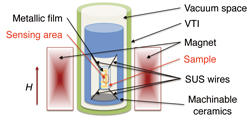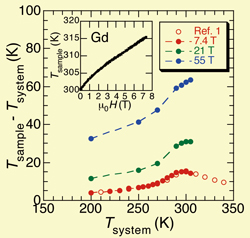Measurement of Magneto-Caloric Effects in Pulsed-High Magnetic Fields
Tokunaga Group
Pulsed magnetic fields have been widely used to study various kinds of magnetic phase transitions in high magnetic fields. The measurable thermodynamic quantity in pulsed fields is, however, mostly limited to the magnetization. Measurements of the other quantity will provide novel possibility for the research of phase transitions in high magnetic fields. In this context, we are trying to develop a measurement system of magneto-caloric effects (MCEs) in pulsed magnetic fields.

Fig.1. Schematic illustration of the measurement system for the MCEs in pulsed magnetic fields. Resistive thermometers are grown directly on top of the sample. With measuring longitudinal magnetoresistance of the calibrated thermometer, we can evaluate the temperature change in the sample located in the center of the pulse magnet.

Fig.2. Temperature change of polycrystalline gadolinium in adiabatic magnetization processes in pulsed fields (solid circles). The data at 7.4 T reasonably coincides with the reported data measured in steady fields (red open circles) [1]. (inset) The measured temperature of polycrystalline gadolinium (Tsample) as a function of applied fields.
Owing to the fast field-sweep ratio, pulsed fields are advantageous to magnetize the sample in the adiabatic condition. The most crucial technical point is how to measure the sample's temperature that changes momentary in pulsed fields. Our solution to this problem is the direct growth of resistive thermometers on top of the sample so as to minimize the heat capacity of the sensor and to maximize the thermal contact between the sensor and the sample. Putting this sample and thermometer in our adiabatic probe as illustrated in Fig. 1, we can measure MCEs in pulsed magnetic fields up to 55 T.
The results of the MCEs in polycrystalline gadolinium is shown in Fig. 2. As demonstrated in the inset, the measured temperature of the sample (Tsample) exhibits a monotonic trace as a function of magnetic field without showing any hysteresis between field-up and –down processes. The absence of the hysteresis gualantee the fast response of the thermometer with a time constant shorter than 0.1 ms. As shown in the main panel, the adiabatic temperature change (Tsample - Tsystem) measured in pulsed fields of 7.4 T (red solid circles) are reasonably coincide with those evaluated in steady fields (red open circles) [1]. In addition, our measurements in pulsed fields demonstrate the magneto-caloric heating over 60 K in applied fields of 55 T. Such direct evaluation of the MCEs in high fields will be effective to study the basic properties in materials useful for the magneto-caloric refrigeration at room temperature [2].
References
- V. K. Pecharsky and K. A. Gschneidner, Jr., Adv. Cryogen. Eng. 42A, 423 (1996).
- E. Bruck, J. Phys. D: Appl. Phys. 38, R381 (2005). D. et al., Appl. Phys. Lett. 91, 022907 (2007)
